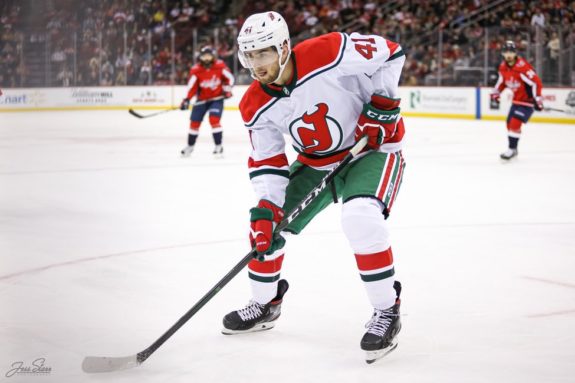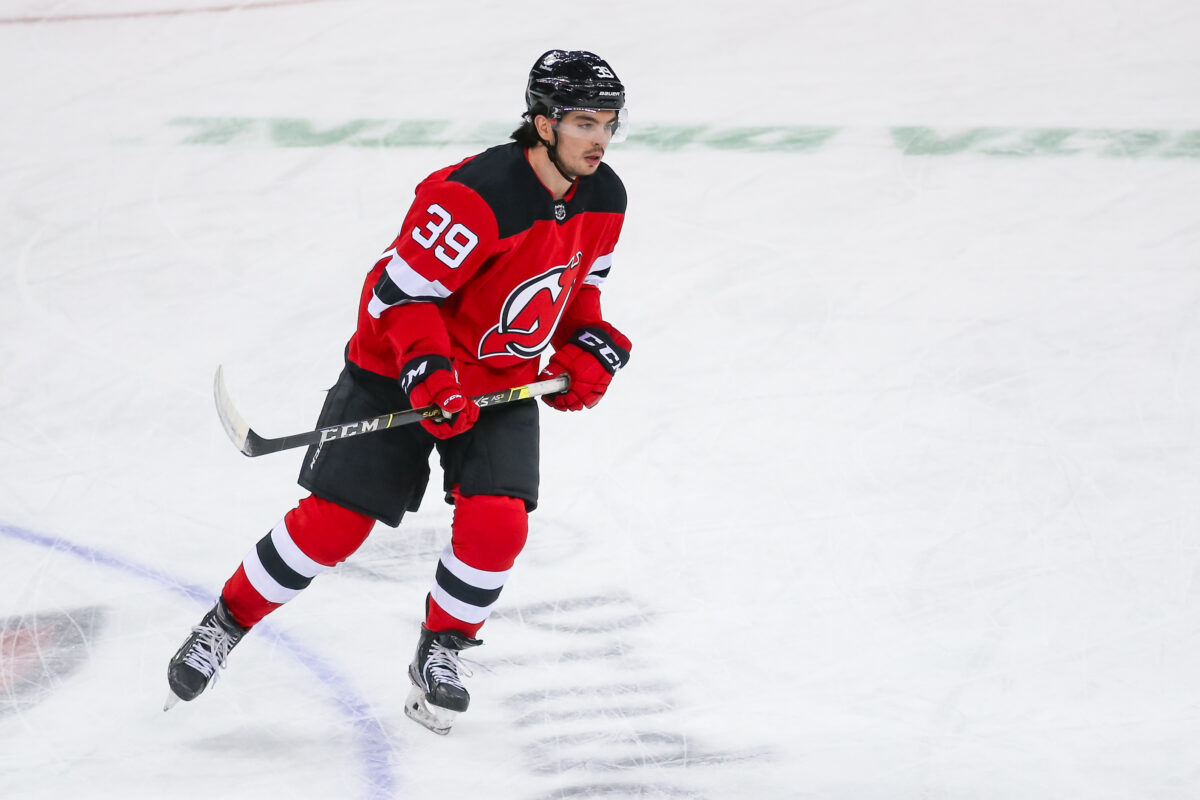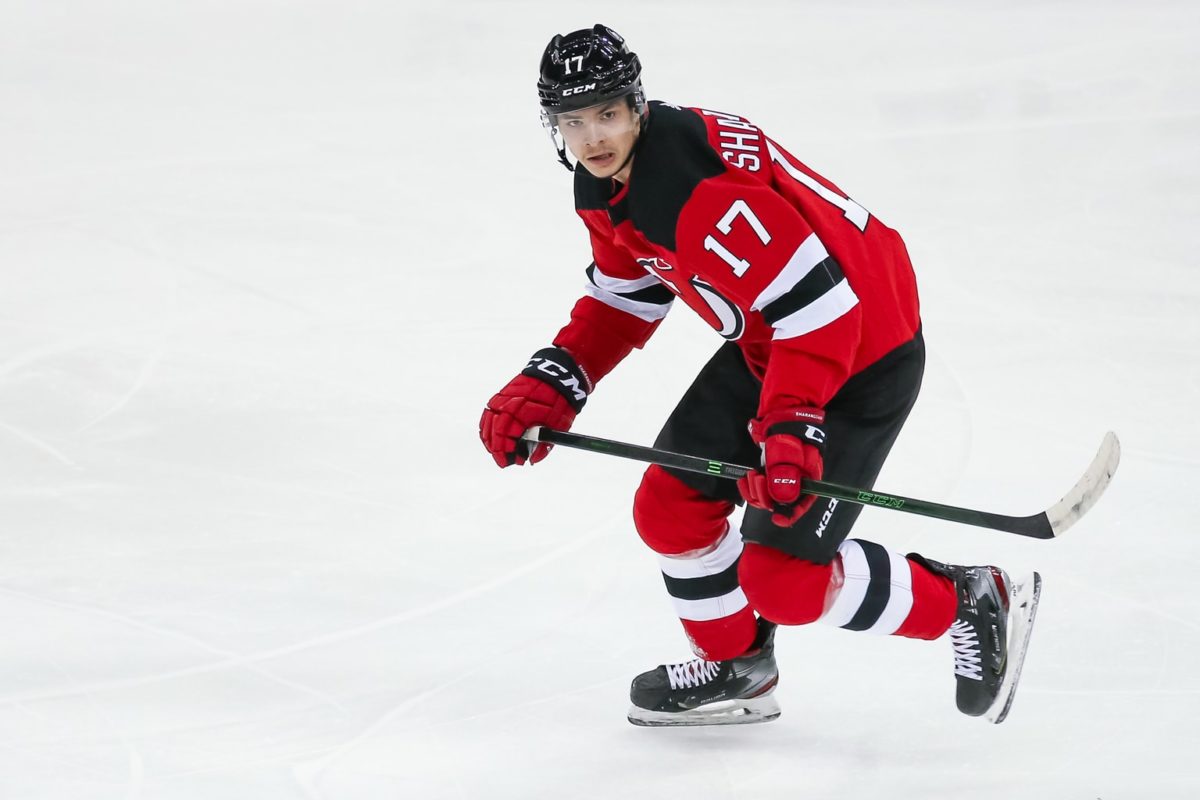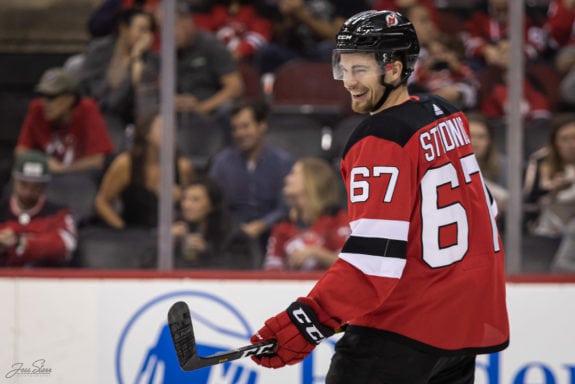The New Jersey Devils are entering the 2021 offseason with just over $37 million in cap space. You can bet they will spend a good portion of that on making improvements to a club that finished 19-30-7 this season. They also need to begin surrounding 2019 first overall pick Jack Hughes with talent, as he looks like he’s on the cusp of turning into one of the league’s best young players.
But before making additions from outside the organization, general manager Tom Fitzgerald will have some housekeeping to do. The Devils have six restricted free agents who played on their NHL club and need new contracts this summer. Let’s take a look at Evolving-Hockey’s contract projections for each RFA, how much they add to the Devils’ salary cap, and why none of them should affect their offseason plans.
Janne Kuokkanen
2020-21 stats: 8 goals, 17 assists in 50 games played (41-point pace over 82 games)
Evolving-Hockey projection: 2 years, $1.517 million cap hit
The Devils acquired Kuokkanen in the trade that sent Sami Vatanen to the Carolina Hurricanes at the 2020 Trade Deadline. He only played in one game for the Devils last season because the COVID-19 pandemic ended their season sooner than expected. But that gave him close to 10 months to work on his game before the 2020-21 season began, and that seemed to help him.
Kuokkanen got off to a slow start this season, with only six points in his first 16 games. But it began to click for him over his final 34 appearances, as he had 19 points — a 45-point pace over 82 games. He finished as the Devils’ fourth-most efficient five-on-five scorer and had the best goals above replacement (GAR) from the team’s rookies.
Related: Devils 2020-21 Report Cards: Hughes, Sharangovich & Kuokkanen Deliver
His projected contract of two years at $1.517 million per year seems like a standard bridge deal, and that’s probably the right approach with Kuokkanen. He’s a budding middle-six winger and gelled with Hughes on the Devils’ first line over the final month of play. But he still has things to improve (like his shot/shooting more often), so there’s no need to sign him long-term yet.
Michael McLeod
2020-21 stats: 9 goals, 6 assists in 52 GP (23-point pace over 82 games)
Evolving-Hockey projection: 2 years, $1.39 million cap hit
There were a few Devils who you could’ve called the surprise player of the year, and McLeod was certainly one of them. After struggling in the AHL during the 2019-20 season, the 10-month layoff between the two seasons appeared to have a significant impact on his development.

McLeod did not light the world on fire, but his nine goals prorate to a 14-goal pace over 82 games. He played his role well as a fourth-line center, and he emerged as one of the team’s best penalty-killers. A bridge deal is the way to go here, too, but I wouldn’t be surprised if it came in a bit under McLeod’s projection. His 82-game pace was 18 points less than Kuokkanen’s, so it feels like there should be a bit more of a gap than $127,000 between their two projections, especially since Kuokkanen’s deal seems like fair value.
Nathan Bastian
2020-21 stats: 3 goals, 7 assists in 41 GP (20-point pace over 82 games)
Evolving-Hockey projection: 2 years, $1.061 million cap hit
Bastian is in the same boat as his good friend McLeod. He found a role that works well for him as a fourth-line winger and settled in as one of the team’s top penalty-killers alongside McLeod. But there a couple of areas where Bastian has a leg up over his linemate.
For one, Bastian’s five-on-five numbers were better than McLeod’s. His GAR of 2.3 was also better than McLeod’s GAR of 0. McLeod probably has more offensive upside moving forward, but this is a pretty fair contract projection for Bastian. I’d also guess that this is closer to what McLeod’s deal looks like instead of the one he’s projected to receive. Either way, two inexpensive bridge deals for a pair of reliable fourth-liners and penalty-killers seem like a decent bit of business.
Nicholas Merkley
2020-21 stats: 2 goals, 8 assists in 27 GP (30-point pace over 82 games)
Evolving-Hockey Projection: 2 years, $1.045 million cap hit
Merkley had a bit of an odd season. He tied with Jesper Bratt as the Devils’ second-most efficient five-on-five scorer. And his point pace over 82 games was respectable, given his limited ice time. He had a positive impact offensively, as his even-strength offense was worth a GAR of 1.8. But even though he contributed offensively, he struggled on defense. The Devils were significantly outshot and out-chanced with him on the ice, and that resulted in him never quite earning head coach Lindy Ruff’s trust.

It’d be a surprise if the Devils didn’t bring back Merkley, who was one of the pieces they received when they traded Taylor Hall to the Arizona Coyotes in Dec. 2019. Merkley does have arbitration rights, but even if it reaches that point, I’d be surprised if his cap hit came in at seven figures. He’s not a regular yet, and that won’t happen until he makes some improvements to his two-way game and skating.
Jonas Siegenthaler
2020-21 stats: No points in 15 GP
Evolving-Hockey projection: 1 year; $950,800 cap hit
After falling out of the Washington Capitals’ regular rotation, the Devils acquired Siegenthaler in exchange for a 2021 third-round pick. Unfortunately, he only played in eight games for the Devils after ending up on the COVID list, but what he did show was encouraging. He finished with an expected goals percentage (xG%) of 54.6 percent and was one of the team’s best shot suppressing defensemen when he played.
Siegenthaler also has arbitration rights, but his negotiation should end up close to his projection. The Devils took a chance on him, hoping he could become a mainstay in the lineup or even a top-four defenseman down the road. If he’s consistently playing in 2021-22, the team should have a pretty good value contract on their hands.
Yegor Sharangovich
2020-21 stats: 16 goals, 14 assists in 54 GP (24-goal, 45-point pace over 82 games)
Evolving-Hockey projection: 4 years, $4.693 million cap hit.
Sharangovich had a breakout campaign with the Devils and finished as one of their top scorers. He was particularly productive over his final 21 games, totaling nine goals and 18 points. His five-on-five numbers for the season weren’t anything spectacular. But over those last 21 games, he finished with a Corsi for percentage of 53.5 percent and xG% of 50.7 percent. It surely helped that he played alongside Hughes for the last five weeks of the season, but he wouldn’t have stuck there if he hadn’t been playing well.
There’s no doubt Sharangovich is the Devils’ most interesting RFA. I’ll admit I was a bit surprised by his projection. With that said, a four-year deal is by no means a lock. Evolving-Hockey gives Sharangovich a 23 percent chance of landing a four-year contract, a 19 percent chance of five years, a 14 percent chance of three or six years, and a 17 percent chance of two years.

If I had to guess, the two sides settle on a bridge deal for two years, which Evolving-Hockey projects at a cap hit of $3.709 million. And that might be the Devils’ best route too. For starters, Sharangovich would be 27 years old at the end of a four-year contract, meaning he’d be an unrestricted free agent. A two-year deal takes him to 25 years old, so he’d still be an RFA. The Devils could then give him a long-term pact and lock him up through his best years.
Sharangovich is a very good skater and has a legitimate wrist shot that should make him a scoring threat for some time, so it’d be a surprise if this season were a fluke. But giving him a bridge deal allows him to prove it wasn’t. And since he’d still remain an RFA, it’d be the Devils’ best move for asset management because he’d be under team control through his prime.
Other RFAs
That covers it for Devils’ RFAs that will likely figure into their NHL ineup for next season. But they still have a few others from their AHL squad that need new deals too. Among them are Colton White, Marián Studenič, A.J. Greer, Gilles Senn, Evan Cormier, Brandon Gignac, Colby Sissons and David Quenneville.
Related: Devils Should Bet on Johnsson Returning to Form
It seems unlikely that Cormier, Senn, Gignac, Sissons and Quenneville will receive qualifying offers, so their Devils tenures appear over. Senn already has signed with HC Davos in Switzerland, the team he played for before the Devils drafted him in 2017. Nor is that much of a surprise given the Devils just signed goaltenders Akira Schmid and Nico Daws to entry-level deals.
White and Studenič are probably safe bets to return for 2021-22. Studenič appeared in eight NHL games this season and could be a reliable depth forward down the road. White saw NHL action this season as well, albeit only in two games. But he’s played well in the AHL and is the kind of player who’s good to have around for depth on the blue line if injuries become a problem.

Finally, there’s Greer, who the Devils acquired when they sent Kyle Palmieri and Travis Zajac to the New York Islanders at the trade deadline. Greer finished with 14 points in 16 games for the Binghamton Devils (AHL), so it wouldn’t be a surprise if New Jersey brought him back for organizational depth.
After all that, let’s say the Devils sign all of their RFAs to Evolving-Hockey’s predicted deals, which would raise their cap hit to $56,796,599. Assuming the salary cap floor remains at $60.2 million, that puts the Devils about $3.4 million UNDER the lower limit. They’re going to have plenty of money available to spend on roster improvements, and no RFA negotiation should affect that. So expect a busy summer in New Jersey as they look to continue building around Hughes and Nico Hischier.
* * *
Advanced stats from Natural Stat Trick, Evolving-Hockey